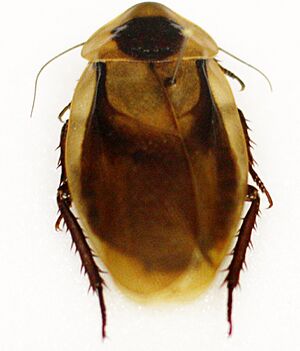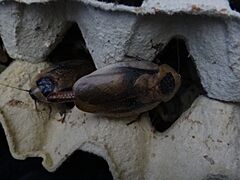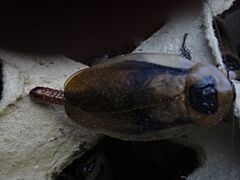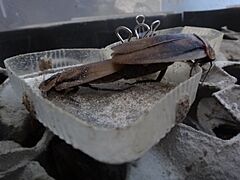Discoid cockroach facts for kids
Quick facts for kids Discoid cockroach |
|
|---|---|
 |
|
| Scientific classification | |
| Synonyms | |
|
The Blaberus discoidalis, often called the discoid cockroach, is a type of "giant cockroach" from Central America. People also know it by other names like the tropical cockroach or West Indian leaf cockroach. It belongs to the Blaberidae family.
Adult discoid cockroaches are about 1.4 to 1.8 inches (35–45 mm) long. They are tan with a dark brown or black spot on their upper back, called the pronotum. Young cockroaches, called juveniles, are brown with tan spots. They grow into adults in about 4 to 5 months. Even though adults have wings, they don't fly much. They also can't climb smooth walls, which makes them easy to keep if you have them as pets.
The discoid cockroach is sometimes called the "false death's head cockroach." This is because it looks a bit like another cockroach, the death's head cockroach (Blaberus craniifer).
Contents
Where Do Discoid Cockroaches Live?

You can find Blaberus discoidalis in many places. They live in Jamaica, Cuba, Hispaniola, and Puerto Rico (including Vieques Island). They are also found in Panama, Colombia, Venezuela, Trinidad and Tobago, and even Florida in the United States.
How Do Discoid Cockroaches Move?
Discoid cockroaches can run quite fast. They can move about 25 times their body length in one second. This is about half the speed of a common house cockroach. Scientists have studied how these cockroaches move. They are very good at climbing over obstacles. They can even stay balanced when something tries to knock them over while they run! Because of their amazing movement, these cockroaches have helped scientists design robots that can move well over rough ground.
Why Are Discoid Cockroaches Useful?
Pet Food
Discoid cockroaches are very easy to raise. This makes them great food for pets that eat insects. Many people feed them to tarantulas, bearded dragons, and other types of lizards.
These cockroaches can have babies easily when kept by humans. They are ready to breed when they are about 6 months old. Keeping them warm, around 85–90°F (29–32°C), helps them have more babies.
Unusual Uses
Cockroaches in Competitions
Sometimes, discoid cockroaches are used in insect-eating contests. This is because they are easy to raise and gather in large numbers for such events.
Cockroaches and Fuel Cells
Scientists have even used Blaberus discoidalis in experiments to create tiny fuel cells. These fuel cells can make electricity from the natural sugar inside the cockroach's body and oxygen from the air. The amount of power these insects can produce is a good goal for designing very small robots.
Image gallery
See also
 In Spanish: Blaberus discoidalis para niños
In Spanish: Blaberus discoidalis para niños




